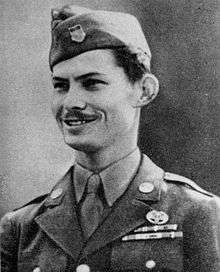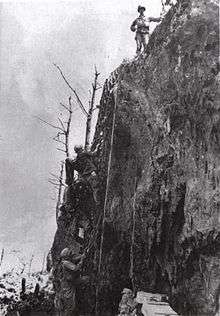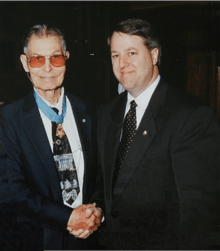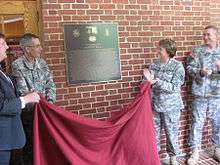Desmond Doss
| Desmond Doss | |
|---|---|
 Doss about to receive the Medal of Honor | |
| Birth name | Desmond Thomas Doss |
| Born |
February 7, 1919 Lynchburg, Virginia |
| Died |
March 23, 2006 (aged 87) Piedmont, Alabama |
| Service/branch | United States Army |
| Years of service | 1942–1946 |
| Rank | Corporal |
| Unit | B Company, 1st Battalion, 307th Infantry Regiment, 77th Infantry Division |
| Battles/wars | |
| Awards |
|
| Spouse(s) |
|
Desmond Thomas Doss (February 7, 1919 – March 23, 2006) was a United States Army corporal who served as a combat medic with an infantry company in World War II. During the Battle of Okinawa, he became the first and only conscientious objector to receive the Medal of Honor for actions above and beyond the call of duty in World War II.
Two other conscientious objectors received the medal in the Vietnam War: Thomas W. Bennett (1947–1969) and Joseph G. LaPointe Jr. (1948–1969). Legendary World War I hero Alvin York (1887–1964) claimed conscientious objector status in 1917, but was denied.
Life
Desmond Doss was born in Lynchburg, Virginia, son of William Thomas Doss, a carpenter, and Bertha E. (Oliver) Doss.[1][2] He stopped attending school after the ninth grade[3] to help support his parents and brother and sister in the Great Depression. At the beginning of World War II, he worked in a shipyard in Newport News, Virginia, in defense work.[4]
Doss was drafted and entered military service on April 1, 1942 at Camp Lee, Virginia.[3] He was sent to Fort Jackson in South Carolina for training with the reactivated 77th Infantry Division. Doss refused to kill an enemy soldier or carry a weapon into combat because of his personal beliefs as a Seventh-day Adventist. He consequently became a medic assigned to 2nd Platoon, B Company, 1st Battalion, 307th Infantry, 77th Infantry Division. While serving with his platoon (each platoon of B Company had one medic) in combat on Guam and the Philippines in 1944, where he was awarded a Bronze Star Medal for aiding wounded soldiers under fire. On Okinawa, he aided and saved the lives of 75 wounded infantrymen from his battalion on top of a ridge during the battle there in 1945; at the same time he was adhering to his religious convictions. Doss was wounded four times on Okinawa,[4] and was evacuated on May 21. In 1946. He was diagnosed with tuberculosis which he contracted on Leyte,[5] which cost him a lung and five ribs. He was honorably discharged in August 1951 with 90% disability.[6][7]
Doss married Dorothy Schutte on August 17, 1942 and they had one child, Desmond Jr. (or Tommy), born in 1946.[8] Dorothy died in 1991 of brain cancer[8] and Doss then married Frances Duman.[9][10] Doss was severely disabled by his wounds and worked on his small farm in Georgia.[8]
Doss died in 2006 at his home in Piedmont, Alabama, after being hospitalized for breathing troubles,[11] the same day as another Medal of Honor recipient, David Bleak. A horse-drawn hearse delivered the flag-covered casket to the grave site while military helicopters flew overhead in a tribute formation.[12] He was buried in Chattanooga, Tennessee's National Cemetery.
Medal of Honor citation

Rank and organization: Private First Class, United States Army, Medical Detachment, 307th Infantry, 77th Infantry Division.
Place and date: Near Urasoe Mura, Okinawa, Ryukyu Islands, April 29, 1945 – May 21, 1945.
Entered service at: Lynchburg, Virginia
Birth: Lynchburg, Virginia
G.O. No.: 97, November 1, 1945.


- Citation:
The President of the United States of America, in the name of Congress, takes pleasure in presenting the Medal of Honor to Private First Class Desmond Thomas Doss, United States Army, for conspicuous gallantry and intrepidity in action above and beyond the call of duty from April 29 – 21 May 1945, while serving with the Medical Detachment, 307th Infantry Regiment, 77th Infantry Division, in action at Urasoe Mura, Okinawa, Ryukyu Islands. Private First Class Doss was a company aid man when the 1st Battalion assaulted a jagged escarpment 400 feet high. As our troops gained the summit, a heavy concentration of artillery, mortar and machine gun fire crashed into them, inflicting approximately 75 casualties and driving the others back. Pfc. Doss refused to seek cover and remained in the fire-swept area with the many stricken, carrying all 75 casualties one-by-one to the edge of the escarpment and there lowering them on a rope-supported litter down the face of a cliff to friendly hands. On May 2, he exposed himself to heavy rifle and mortar fire in rescuing a wounded man 200 yards forward of the lines on the same escarpment; and 2 days later he treated 4 men who had been cut down while assaulting a strongly defended cave, advancing through a shower of grenades to within eight yards of enemy forces in a cave's mouth, where he dressed his comrades' wounds before making 4 separate trips under fire to evacuate them to safety. On May 5, he unhesitatingly braved enemy shelling and small arms fire to assist an artillery officer. He applied bandages, moved his patient to a spot that offered protection from small arms fire and, while artillery and mortar shells fell close by, painstakingly administered plasma. Later that day, when an American was severely wounded by fire from a cave, Pfc. Doss crawled to him where he had fallen 25 feet from the enemy position, rendered aid, and carried him 100 yards to safety while continually exposed to enemy fire. On May 21, in a night attack on high ground near Shuri, he remained in exposed territory while the rest of his company took cover, fearlessly risking the chance that he would be mistaken for an infiltrating Japanese and giving aid to the injured until he was himself seriously wounded in the legs by the explosion of a grenade. Rather than call another aid man from cover, he cared for his own injuries and waited 5 hours before litter bearers reached him and started carrying him to cover. The trio was caught in an enemy tank attack and Pfc. Doss, seeing a more critically wounded man nearby, crawled off the litter; and directed the bearers to give their first attention to the other man. Awaiting the litter bearers' return, he was again struck, by a sniper bullet while being carried off the field by a comrade, this time suffering a compound fracture of one arm. With magnificent fortitude he bound a rifle stock to his shattered arm as a splint and then crawled 300 yards over rough terrain to the aid station. Through his outstanding bravery and unflinching determination in the face of desperately dangerous conditions, Pfc. Doss saved the lives of many soldiers. His name became a symbol throughout the 77th Infantry Division for outstanding gallantry far above and beyond the call of duty.
Military awards
Doss received the following decorations and awards:
| Medal of Honor | |
| Bronze Star Medal with one Oak Leaf Cluster and "V" Device [13] | |
| Purple Heart with two Oak Leaf Clusters | |
| Army Presidential Unit Citation | |
| Meritorious Unit Commendation | |
| Good Conduct Medal | |
| American Campaign Medal | |
| Asiatic-Pacific Campaign Medal with three 3⁄16" bronze stars and arrowhead device | |
| World War II Victory Medal | |
| Philippine Liberation Medal with one 3⁄16" bronze star | |
 |
Combat Medical Badge |
Other honors and recognition


On July 10, 1990, a section of Georgia Highway 2 between US Highway 27 and Georgia Highway 193 in Walker County was named the "Desmond T. Doss Medal of Honor Highway."[14]
On March 20, 2000, Doss appeared before the Georgia House of Representatives and was presented a special resolution honoring his heroic accomplishments on behalf of the country.[15]
In July 2008, the guest house at Walter Reed Army Medical Center in Washington, D.C., was renamed Doss Memorial Hall.[16]
On August 30, 2008, a two-mile stretch of Alabama Highway 9 in Piedmont was named the "Desmond T. Doss Sr. Memorial Highway."[17]
He was a resident of Lynchburg, Virginia, in which a portion of US Route 501 near Peaks View Park is named in his honor. Local veterans of the area still honor him by decorating the signs marking this portion of road several times during the year, particularly around patriotic holidays and especially Memorial Day.
In the early 1980s, a school in Lynchburg was renamed Desmond T. Doss Christian Academy. The school was founded by the Lynchburg Seventh-Day Adventist Church, the home church of Desmond Doss during his years in Lynchburg. The church wanted to honor Doss for standing strong in his faith, both as a Christian and as a Seventh-Day Adventist, as well as in the face of great adversity.[18] Desmond Doss visited the school that bears his name three times before his death,[19] and he even demonstrated to some of the students how he tied the bowline knot that saved the lives of so many of his fellow soldiers during the Battle of Okinawa at Hacksaw Ridge.[18]
On October 25, 2016, the City of Lynchburg, Virginia, honored Desmond Doss once again. This time they awarded a plaque in his honor to Desmond T. Doss Christian Academy to be hung at the school that bears his name. The City Council meeting opened with students from Desmond T. Doss Christian Academy leading the group in the Pledge of Allegiance. Immediately following the Pledge, the Vice Mayor of Lynchburg presented the plaque to the school's principal, Steve Doss.[20]
In popular culture
The feature film, Hacksaw Ridge, based on his life, was directed by Mel Gibson and was released nationwide in the U.S. on November 4, 2016 to positive reviews. In the film, Doss is played by Andrew Garfield.
Doss is the subject of The Conscientious Objector, an award-winning documentary in 2004.[21] He also is the subject of the book The Unlikeliest Hero.[22]
On February 18, 1959, Doss appeared on the Ralph Edwards NBC TV show This Is Your Life. [23]
Doss was also featured in the Medal of Honor Special comic written by Doug Murray and published by Dark Horse Comics. The comic was a special edition of the series Medal of Honor, published April 1, 1994. The title was sanctioned by the United States Congressional Medal of Honor Society.[24] The issue features Corporal Desmond Doss along with another Medal of Honor recipient, Lieutenant Charles Q. Williams.[25]
See also
- List of Medal of Honor recipients
- List of Medal of Honor recipients for World War II
- Medical Cadet Corps
References
- ↑ "In Memory of Harold Edward Doss". Brown Funeral Home. Retrieved August 1, 2015.
- ↑ "Desmond T. Doss".
- 1 2 "WWII Army Enlistment Records". June 30, 2005.
- 1 2 U.S. Army interview, 20 March 1987
- ↑
- ↑ Herndon, Booton (1967). The Unlikeliest Hero. Boise, Idaho: Pacific Press Publishing Association. p. 182. ISBN 0-8163-2048-9.
- ↑ This is Your Life - Desmond Doss, February 18, 1959 You Tube
- 1 2 3 Hacksaw Ridge vs the True Story of Desmond Doss, Medal of Honor
- ↑ Hacksaw Ridge: The True Story of Desmond Doss
- ↑ Lauded Conscientious Objector Desmond T. Doss Sr
- ↑ Richard Goldstein (March 25, 2006). "Desmond T. Doss, 87, Heroic War Objector, Dies". New York Times. Retrieved June 16, 2013.
- ↑ "'Unlikeliest Hero' buried with 21-gun salute". 4 April 2006.
- ↑ Herndon, Booton (2016). Redemption at Hacksaw Ridge. Remnant Publications. p. Foreward. ISBN 978-1-629131-55-9.
- ↑ "Walker County". Calhoun Times. September 1, 2004. p. 108. Retrieved April 26, 2015.
- ↑ "HR 206 – Doss, Desmond T.; invite to House – Fulltext".
- ↑ Guest House named after Medal of Honor recipient, WRAMC News Releases, July 17, 2008. Retrieved on August 31, 2008.
- ↑ Piedmont Medal of Honor recipient honored with state highway designation, The Anniston Star, Michael A. Bell, August 31, 2008. Retrieved on August 31, 2008.
- 1 2 "History of Desmond Doss – Desmond T. Doss Christian Academy".
- ↑ "Remembering visits from Mr. Desmond T. Doss, the man for whom our school is named - Desmond T. Doss Christian Academy". 17 May 2016.
- ↑ "Desmond Doss' Hacksaw Ridge Heroics and School Honored".
- ↑ "The Conscientious Objector". imdb.com. 2013. Retrieved January 29, 2013.
- ↑ "'Unlikeliest Hero' buried with 21-gun salute". 4 April 2006.
- ↑ "Classic TV Info - This Is Your Life Episode List".
- ↑ "Medal of Honor Special". (September 17, 2014). Dark Horse Comics. Retrieved November 6, 2016.
- ↑ Pritzker Military Museum & Library online catalog. "Medal of Honor Special". (September 17, 2014).
Further reading
- Leepson, Marc (2008), "Wonder Man of Okinawa," Military History magazine, September/October 2008, Vol. 25, No. 4.
- Herndon, Booton (2004). The Unlikeliest Hero: The Story of Desmond T. Doss, Conscientious Objector Who Won His Nation's Highest Military Honor. Mountain View, California: Pacific Press Publishing Association. ISBN 978-0-8163-2048-6..
- Doss, Frances M. (2005). Desmond Doss: Conscientious Objector. Pacific Press Publishing Association. ISBN 978-0-8163-2124-7.
- Doss, Frances M. (1998). Desmond Doss: In God's care: The unlikeliest hero and Congressional Medal of Honor recipient. The College Press.
- Smith, Larry (2003). Beyond Glory: Medal of Honor Heroes in Their Own Words. Norton. ISBN 039305134X.
External links
- "Official Desmond Doss Website". Retrieved July 28, 2016.
- Desmond Doss at Find a Grave
- "The Conscientious Objector (2004 film)". Internet Movie Database. Retrieved September 29, 2010.
- "Desmond Doss: The Conscientious Objector". desmonddoss.com.
- "North America: Filmmaker Documents Story of Desmond Doss". Claim to Fame: Medal of Honor recipients. Adventist News Network. 18 November 2003.
- "Desmond T. Doss Christian Academy, a Seventh-Day Adventist school in Lynchburg, Virginia". Retrieved September 29, 2010.
- "Obituaries:Desmond Thomas Doss, Sr., MOH". Retrieved May 8, 2016.
- ^ "Medal of Honor recipients World War II (A-F)". United States Army Center of Military History
- "Burial Set April 3 At National Cemetery For Medal of Honor Winner Desmond Doss". The Chattanoogan.
- Leepson, Marc (2015). "Desmond Thomas Doss (1919–2006)", Dictionary of Virginia Biography, Library of Virginia (1998–)
- Soper, Matthew (April 2002). "Desmond Doss: A War Hero Without a Gun". Incredible People Magazine.